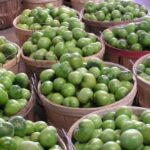Living the religious communal life does not mean sacrificing the simple pleasures one can enjoy. For the Mennonites, taking pleasure through food is one of the ways they celebrate the fruits of their labors, for the Mennonites areexcellent farmers and cooks. As descendants of the Anabaptists, the Mennonites have a strong work ethic that has also permitted them to share their fruits, vegetables, baked, and canned foods with non-Mennonites. Their work in war-time relief is well known, when they shipped food and supplies to those who needed it in Europe during World War 2. Since their food was always fresh and prepared right after being picked from the soil, the Mennonites never had to worry about crops going bad or wasted.
Living the religious communal life does not mean sacrificing the simple pleasures one can enjoy. For the Mennonites, taking pleasure through food is one of the ways they celebrate the fruits of their labors, for the Mennonites are excellent farmers and cooks. As descendants of the Anabaptists, the Mennonites have a strong work ethic that has also permitted them to share their fruits, vegetables, baked, and canned foods with non-Mennonites. Their work in war-time relief is well known, when they shipped food and supplies to those who needed it in Europe during World War 2. Since their food was always fresh and prepared right after being picked from the soil, the Mennonites never had to worry about crops going bad or wasted.
The Mennonites planted a wide variety of vegetables and fruits during each growing season. They knew how to make the most of the soil, composting it so they would receive a maximum crop growth each year. Fruit trees such as apples, plums, peaches, cherries, and pears grew in orchards on their farms. Mennonite women spend much time preparing jelly preserves and making all kinds of delectable desserts from scratch. While many main dishes for breakfast, lunch, and dinner had minimal seasoning, Mennonites became known for their desserts which might be sold to non-Mennonites several times during the year. Stores located nearby the communities carry such foods so that non-Mennonites might be able to appreciate and enjoy the work of those who made the foods.
The average Mennonite lunch and supper consists of pork, chicken or beef cooked in butter and salt, with vegetables like asparagus, corn, peas, tomatoes, beets, or string beans. Salads were plain and were usually made of shredded lettuce and tomatoes, with the occasional radish and carrot chopped up and tossed in. Since the food was grown organically, and the meat without any hormones injected, the Mennonite diet is considered extremely healthy, despite the wide number of baked goods in addition to the breads they made.
It is not at all difficult to have the diet of a Mennonite if you have your own vegetable garden. If there are no fruit trees in your yard and you can’t afford to purchase one, you can easily purchase organically grown fruits from the local farmer’s market. Cooking meals like a Mennonite requires time and patience, as simple as the meals are. This means taking the time to wash and cut up the vegetables from your garden. As for meats, purchase those that are organic, too. Health food stores usually carry meats that are safe and healthy and hormone-free.
Lastly, here is one easy recipe of my creation you can try for your family supper:
Chicken and Asparagus
Serves 4
4 boneless breasts of organic chicken
4 organic baking potatoes
12 asparagus spears
low-cholesterol butter or margarine
salt
pepper
Preheat the oven to 400 degrees. Prepare the chicken by placing the breasts on an aluminum covered baking sheet. Lightly salt and pepper the meat. Cover the chicken with another layer of aluminum foil.
Place the chicken in the oven. Wash the potatoes well and cut each one in half lengthwise. Place a small half square of butter on the top of each potato half then add some salt and pepper. Arrange the potatoes on another aluminum foil covered tray and place in the oven.
Wash the asparagus then lay on a cutting board. Make sure all of the spears are evenly placed at the ends before cutting. Cut the spears into thirds with a sharp knife. Boil a pot of salted water then add the asparagus. Cook until tender, but not too soft. Once the food is done, it is ready to be served.
Twenty Most Asked Questions About the Amish and Mennonites. Merle and Phyllis Good. Intercourse, PA: Good Books. 1995.
http://www.horseshoe.cc/pennadutch/religion/mennonites/menn.htm




